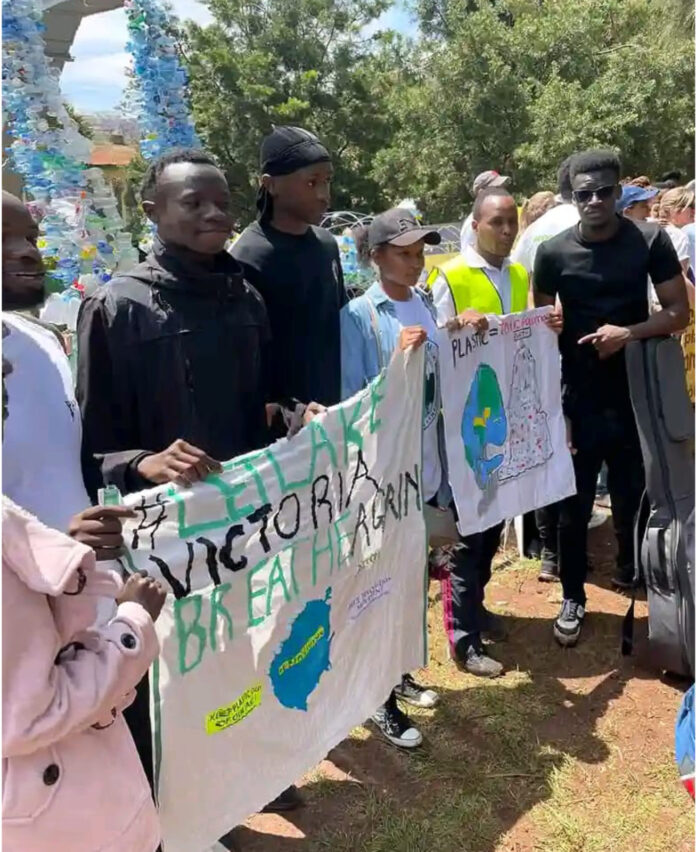In the fight against climate change and environmental degradation, campaigns and slogans play pivotal roles in raising awareness, shaping public opinion, and driving actionable change. Campaigns broadly address environmental issues by educating the public and advocating for specific changes, while slogans serve as memorable calls to action. One such impactful slogan is “There Is No Planet B.”
A stand out example of grassroots activism is the “Let Lake Victoria Breathe Again” campaign, initiated by Rahmina Paullet, a founding member of the Kisumu Environmental Champions. “Lake Victoria is more than just a lake but it is a crucial lifeline for million of livelihood”, say Rahmina. The campaign has been able to mobilize a number of volunteers and young people to robust Climate Change.
This initiative has made significant strides in rejuvenating Lake Victoria by tackling pressing issues like severe pollution and overfishing, invasive species , industrial waste , untreated sewage that have lead to suffocation of aquatic life ,algae bloom and reducing water quality Through dedicated efforts in clean-up operations and raising of awareness the campaign has shown that targeted actions and community involvement can lead to substantial environmental improvements.
Combating pollution that has severely affected Lake Victoria for decades unchecked especially from untreated sewage, agricultural runoff have led to severe eutrophication. Algae blooms have surged depleting Oxygen level killing a lot of aquatic life. Plastic pollution is also a threat to lake Victoria as it harm aquatic life through entanglement , ingestion and also put human health at risk who consume the fish.
The Kisumu Environmental Champions have been at the forefront of addressing this issue through organized clean-ups, restoration activities, and community mobilization. Their efforts have led to noticeable reductions in pollution levels, focusing on removing key pollutants like plastic bottles and ending release of untreated sewage into the Lake.
The campaign’s educational initiatives have been crucial in fostering environmental stewardship within the local community. By highlighting the importance of proper waste disposal, reducing pollution, maintaining clean water , encouraging reforestation through tree planting section and events and educating them on suitability practices ,have contributed to a decrease in waterborne diseases and contamination, increase in the number of trees grown and maintained These educational efforts have not only raised awareness but also spurred community involvement, furthering the campaign’s success.
Addressing overfishing ,,overfishing poses another significant threat to Lake Victoria, depleting native fish species and disrupting the ecological balance, which in turn affects the livelihoods of local fishermen. The “Let Lake Victoria Breathe Again” campaign has addressed this issue by educating fishermen on sustainable fishing practices and the use of appropriate gear. These efforts aim to prevent overfishing and support the lake’s ecological balance.
Managing water hyacinth, another major challenge for Lake Victoria is the invasive water hyacinth, which blocks sunlight, depletes oxygen levels, and disrupts local fisheries. The campaign has supported initiatives to remove water hyacinth through hand picking and explored sustainable uses for the plant, such as producing eco-friendly products like bags through Rahmina Paullet Eco-products. These efforts not only address the immediate environmental impact but also provide economic opportunities for the local community as well as relief to Lake Victoria as it is noticeable that there has been a reduction in water hyacinth in the lake.
A comprehensive approach, the multifaceted efforts of the “Let Lake Victoria Breathe Again” campaign exemplify a comprehensive approach to environmental conservation. By addressing pollution, overfishing, and invasive species, the campaign demonstrates the importance of targeted interventions, community engagement, and sustainable practices in restoring and preserving vital ecosystems.
The success of this campaign underscores the power of grassroots activism and the collective effort required to tackle complex environmental challenges. As Lake Victoria begins to recover, the “Let Lake Victoria Breathe Again” campaign serves as a beacon of hope and a model for similar initiatives worldwide. Through continued dedication and community involvement, Lake Victoria can once again thrive, providing a healthy ecosystem for future generations. “We have made significant progress but still much work to be done ,our goal is to ensure that Lake Victoria not only survives but also thrive to providing a sustainable future for the next generation” says Rahmina Paullet .
Finally, the “Let Lake Victoria Breathe Again” campaign illustrates the significant impact that well coordinated, community-driven efforts can have on environmental conservation. By addressing key issues like pollution, overfishing, and invasive species, and fostering a sense of stewardship within the local community, this campaign has paved the way for a healthier, more sustainable Lake Victoria.
Edith Awino is a kisumu based climate change activist









